B-17G Flying Fortress ‘Her Did ’, Calvi
Corsica is a spectacular place. Inland from the rugged coastline’s turquoise waters, mountains rise steeply, their towering granite summits patched white with snow even in the late spring. I stared out the window as the bus wound it’s way from Bastia to Calvi, through valleys cut by fast flowing rivers and over steep mountain passes. We descended into the town in the early evening, where the 400 year old walls of the citadel glowed red with the last rays of the sun.
‘I was a member of the 340th Bomb Squadron, 97th Bomb Group (H), 15th Air Force flying bombing missions out of Foggia Main Army Airfield, Foggia, Italy. Little did I know on February 14, 1944…that my crew and I would take our last flight on aircraft number 31044, a B-17G assigned to our crew for this mission.’ 1 2nd Lt. Armand C. Sedgeley, Bombardier, 22 years old
A short walk and I arrived at my accommodation: a tidy cabin in a camping ground full of Australian eucalypts and flowering Callistemon. I had arrived in town after business closing time, and the only option for dinner was a wood-fired pizza from a van outside the campground. It was a mild evening and I sat on a rock wall as my order was prepared, listening to frogs calling in a nearby creek.
‘We were flying a high altitude mission to Verona, Italy…to bomb the railroad marshalling yards…’ 1 2nd Lt. Armand C. Sedgeley
The holiday vibe of the place, and the Aussie trees and shrubs, brought on feelings of nostalgia for summers long-gone. However tomorrow would bring new experiences: I would be diving on Corsica’s most famous wreck, the B-17G Flying Fortress 31044 christened ‘Her Did’.
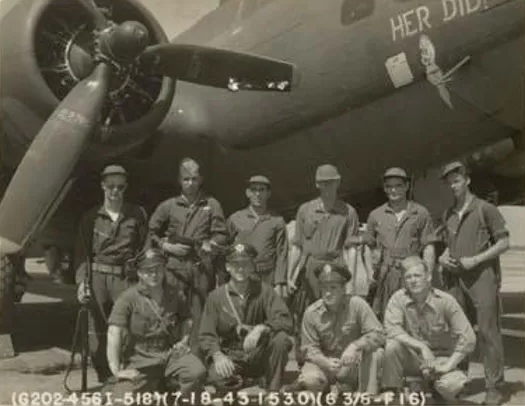
‘I estimate that we had been on the bomb run for three minutes…when I looked up…and saw two fighters flying towards us…The tail gunner kept calling off fighters…and he started to fire. The next thing I heard was the tail gunner call that his guns were out of commission…The next thing that came over the intercom was the tail gunner’s voice saying that he was dying.’ 1 2nd Lt. Armand C. Sedgeley
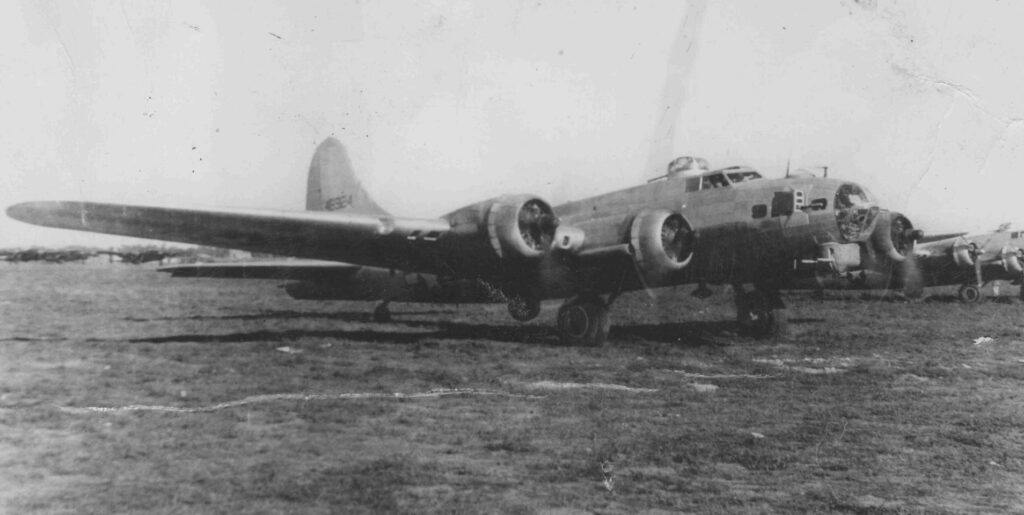
Next day, I walked the short distance to Calvi’s long sweep of sandy beach, and headed towards the marina. I was soon at the dive centre, being kitted out with a wetsuit and gear.

Four of us clambered into a small inflatable, and our dive leader gave us a briefing. Using a model of a B-17, he explained the orientation of the bomber on the sea bed, and how we would approach and examine the wreck. We left our marina berth, and after rounding the breakwater, we were only a few minutes from our mooring point beneath the Citadel’s towering walls.
’20mm explosive shells hit my turret, blew glass in front of me and behind me and ruined my (gun)sight… The fourth enemy aircraft shot the dome off my turret. Thereafter, all I could do was point my guns at them and hope.’ 4 Technical Sergeant Frank E. Bradley, Engineer and Top Turret Gunner
I know we were being hit…as the nose was full of smoke and dust…I noticed two P47 Thunderbolts (American fighter aircraft) approaching from ahead and the Me. 109’s (German fighter aircraft) left us immediately. There was no more shooting.’ 1 2nd Lt. Armand C. Sedgely
After putting on our gear we somersaulted backwards from the boat into the clear, cool water. As we bobbed on the surface, our dive leader checked everyone was ready, and on his signal we began our descent. Following the mooring buoy’s anchor rope downwards, we were soon on the rocky sea floor.
‘I…went to the radio room where I found the radio operator (24 year old Technical Sergeant Robert F. Householder) lying face down on the floor. I turned him over and saw a bullet wound in his left eye…I left the radio room and went to the waist position where the left waist gunner (22 year old Staff Sergeant George J. Murphy) was lying face up on the floor…I thought he was only unconscious…The ball turret gunner (Staff Sergeant Orville F. Grilliot) helped me carry this man to the radio room…I discovered a bullet wound that entered his chest and another larger hole in his belly…I left him for dead…I went to the tail where I found the gunner (33 year old Staff Sergeant Tony Duca) lying on the floor. He was conscious but bleeding so heavily…I gave him a shot of morphine…He became unconscious after a short time and there was nothing more I could do for him.’ 1 2nd Lt. Armand C. Sedgeley
We followed the dive leader around boulders, through chasms and over drop-offs, all the while descending as the sea bed fell away from the island. We crossed a shelf of rock, green with sea growth, and before us, lying in 28 metres of water on a bed of sand, was Her Did.
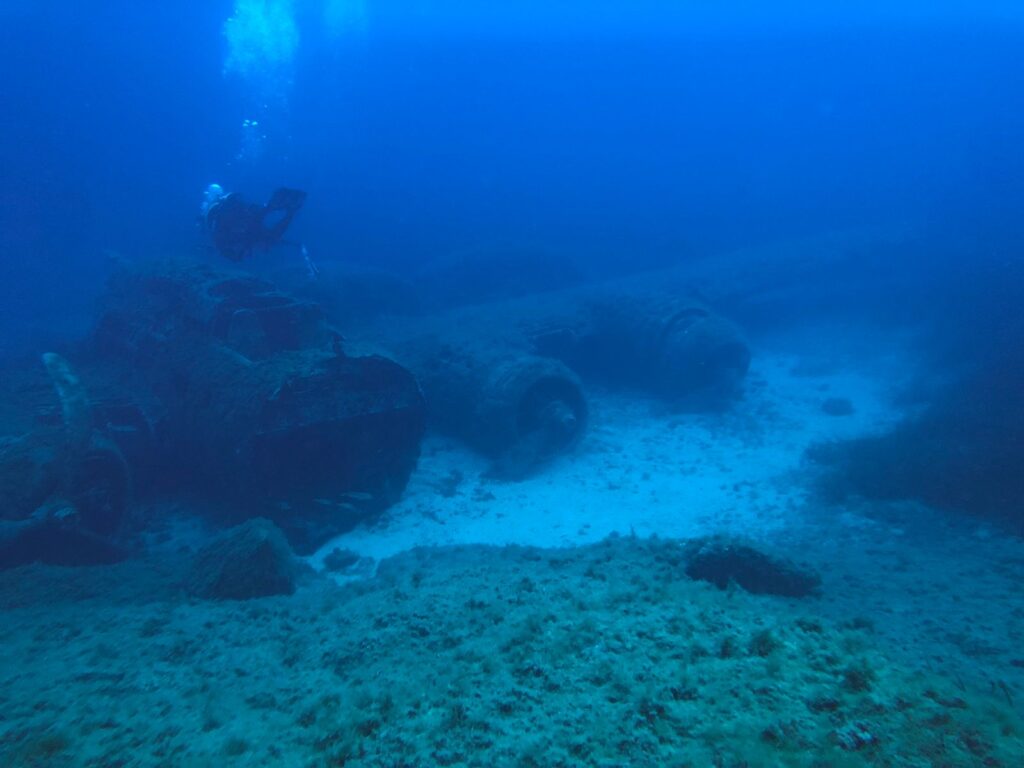
‘Had quite a time keeping ship on course due to trim controls being shot out…On initial attack I was hit by 20 mm and flying glass, causing my hand to become numb and making flying very difficult with only one hand..5 With two engines on fire and a third coughing, we didn’t have much left to do, except hang on to the controls…‘ 6 2nd Lt. Frank G. Chaplick, Pilot, 23 years old

The Flying Fortress was a giant of its time, and although battered by war and nearly 80 years under the sea, Calvi’s B-17 still looked impressive. Despite having lost its nose, from front-on the aircraft appeared pretty much intact. Three of the four engines still had their propellers in place (though only one still had all three blades), and the pilots’ seat backrests were clearly visible in the cockpit.
‘I went back to the cockpit and was ordered by the pilot to throw out all the equipment possible. By the time this was completed we were off the coast of Corsica.’ 4 Technical Sergeant Frank E. Bradley
‘As we came in sight of Calvi airport, which was a very short runway and mountains on each side, a lot of smoke was coming out of the engines.8 I then decided, despite our two engines now cut off (the fire having been extinguished thanks to the wing extinguishers), to make a first pass to evaluate the terrain. Finding ourselves back over the sea, I was making our final approach when the third engine hit stopped without warning. Not having enough power at this precise moment and immediately losing altitude, I had only one choice: to land’ 6 2nd Lt. Frank G. Chaplick
When I got closer to the aircraft, however, I could see the fuselage was missing aft of the wing’s trailing edge. I later found there were two theories of what happened to the missing fuselage and tail. One suggests the impact with the water broke the tail away from the rest of the B-175, and another that interference with the wreck after the crash caused the separation.2,6 **
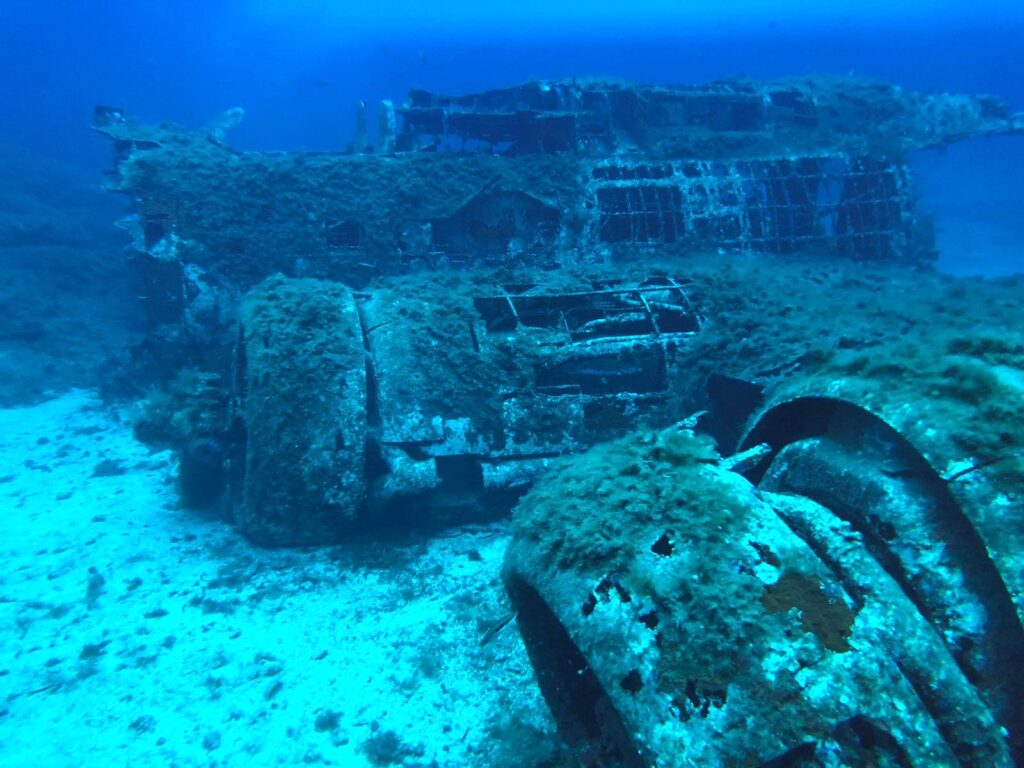
‘This is how I put the B17 on the waves, very close and facing the citadel of Calvi. The plane did not break during the operation, and floated for a few minutes, which allowed us to evacuate it, except for the three machine gunners killed during the attack and whose bodies sank with the wreckage…’ 6 2nd Lt. Frank G. Chaplick
I am only a relative beginner at diving, but have been lucky to explore a number of wrecks. When at a wreck site, I often find my focus is jarred away from the heavy steel, nuts-and-bolts remains of the vessel by something that is more intimately connected to the human story. A cabin, a bedframe or bathtub, or visiting the ship’s bridge, takes my attention from the tangible to the crew who experienced the tragedy. Diving on Her Did was no different.
Floating above the cockpit, the two pilots’ stations were clear to see: 2nd Lt. Chaplick’s seat on the left, and his co-pilot 2nd Lt. Ward H. Skaggs to the right, and between them the centre console that held the engines’ throttle controls. I could only imagine the scene inside the cockpit as the B-17 limped towards Calvi, and the physical and mental stress endured by these two young men.
Behind the pilot’s seats, a ring marked the position of the machine gun turret that once held twin 50 calibre machine guns. As quoted above, the turret of Technical Sergeant Frank. E. Bradley, the Engineer and Top Turret Gunner, was destroyed around him by the enemy fighters over Italy.
From the rear of the wreck, a door can be seen. From what I can ascertain of the B-17’s layout, this door would lead, if a crewman was moving aft, from the bomb bay to the radio operator/gunner’s position. As described in the direct quotation above, it would have been through this door that 2nd Lt. Armand C. Sedgeley would have passed to reach the lifeless body of radio operator Technical Sergeant Robert H. Householder.
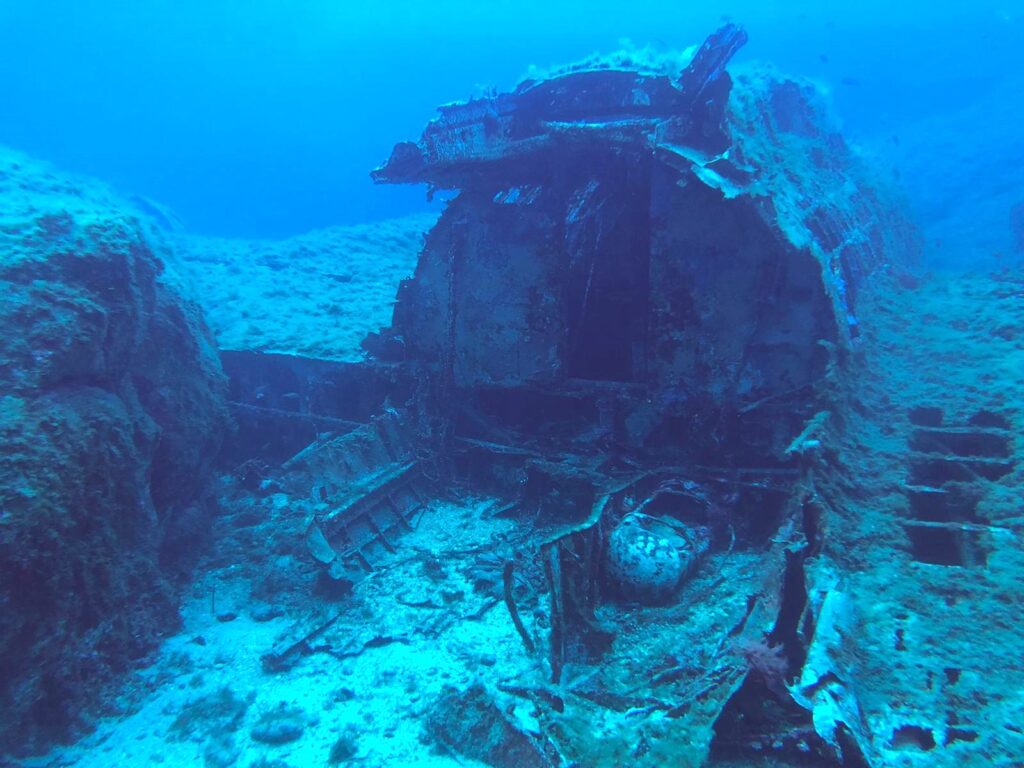
‘I dug the raft out on the pilot’s side and the ball-turret man did likewise on the co-pilot’s side. While the raft was inflating I removed my flying boots and overalls. Our aircraft was settling fast, so we went into the water shoving our raft out of the way of the stabiliser.’ 4 Technical Sergeant Frank E. Bradley
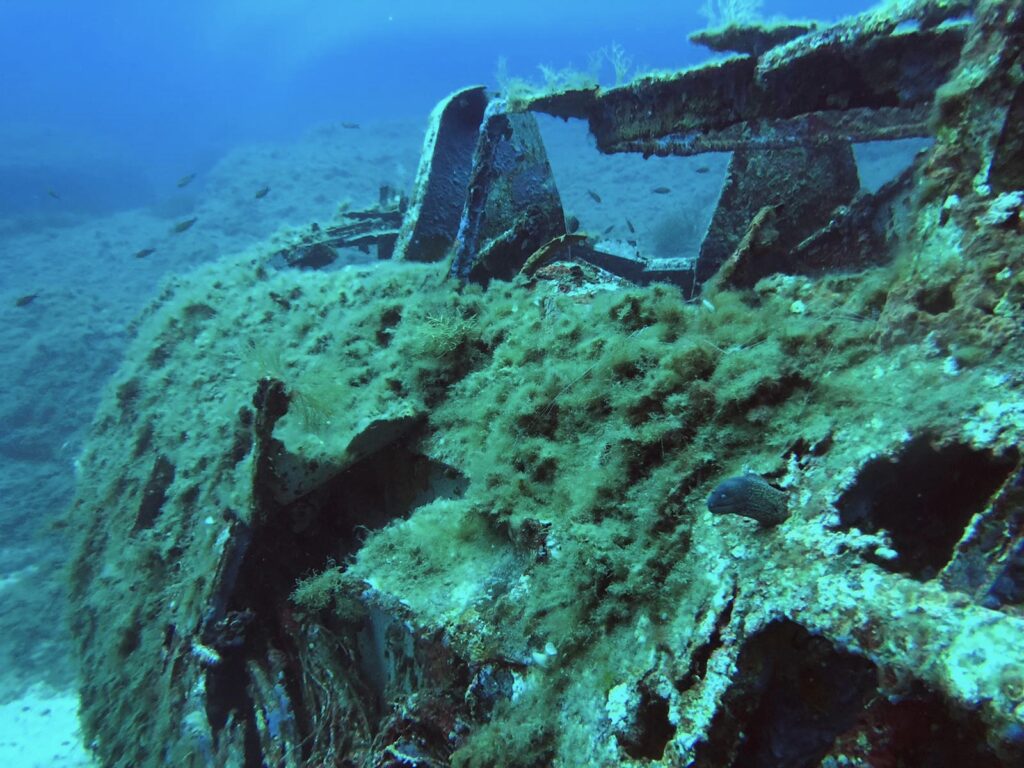
‘Upon impact, the table with radar jamming equipment hit me in the chest and pinned me against the wall…I opened my CO-2 to inflate my ‘Mae West’ preserver and struggled to get the table pushed back so I could exit the aircraft…I believe that I floated out of the top fuselage hatch, as the water was filling the aircraft. I was the last man out of the sinking bomber…1 …all the others were in the dinghy by the wing, waiting for me. I don’t know how, to this day, I was able to hold my breath that long. I have no recollection. But I did and was able to get out. Somehow, I was very fortunate.‘ 9 2nd Lt. Armand C. Sedgeley
Our time exploring the Flying Fortress seemed to go in a flash, and before I knew it our leader was signalling us to gather at the front of the aircraft. Lying on our backs, we kicked away from the enormous plane, watching it slowly fade from view. When we surfaced near the Citadel walls, I thought how close the B-17 had come to making landfall. Sadly, those crew members killed that day in 1944 were dead before the bomber ditched into the Mediterranean. Perhaps the loss of life may have been greater had Her Did made it far enough to crash land onto the Corsican mainland.
‘We were in the water approximately 20 minutes before a British Air-Sea Rescue Launch picked us up. They immediately removed our clothing and provided blankets and stimulants and took us to Calvi.’ 1 2nd Lt. Armand C. Sedgeley
That afternoon I walked up Calvi’s steep streets to the Citadel. Following the harbour-side wall, I was soon looking west down over the water, and found the buoy where we had moored that morning. From the buoy I followed a line out to sea, estimating where the B-17 lay.
‘Upon reaching shore we were taken to 4th Fighter Squadron, 52nd Group and given medical attention, dry clothing and beds.’ 4 Technical Sergeant Frank E. Bradley
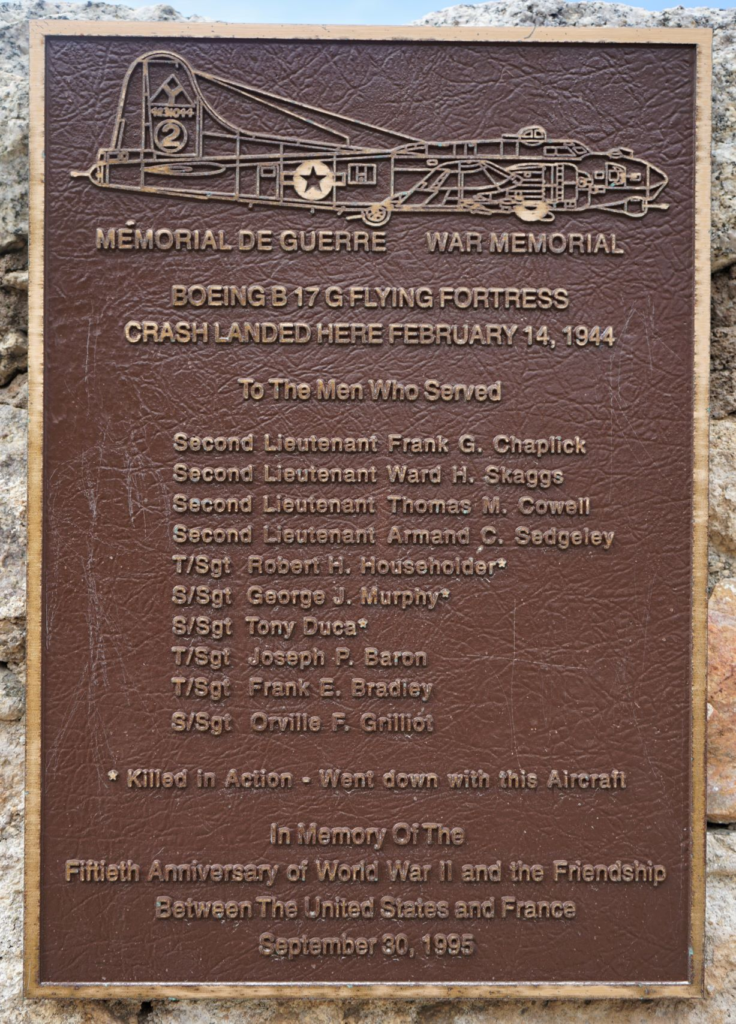
To my left I noticed a brass plaque affixed to the wall; a memorial to the events of 14th February 1944, and for those crew members who remained with Her Did as she settled beneath the waves.
In the warmth of the late afternoon sun, I walked back along the beach to my campground with its smell of eucalyptus and brilliant red bottle-brushes. It had been an amazing experience to dive on Calvi’s B-17, an underwater monument to the sacrifices made, so long ago, by young men far from home.
A little research will turn up 19 publicised World War II aircraft wrecks scattered around the coastline of Corsica. Considering the number of planes stationed on the island’s 17 WWII aerodromes during the hostilities, I imagine there are many more crash sites both known and unknown.
Her Did is regularly visited by holiday makers from all over the world. During the height of the tourist season, I imagine several groups of divers would descend the 28 metres to see her every day. But how many of Corsica’s ghosts lie undisturbed beneath the Mediterranean’s clear waters, still holding tightly to their secrets of survival and tragedy, after nearly 80 years?
**Technical Sergeant Frank E. Bradley’s first-hand account (quoted later in the post) of the moments after the landing ‘Our aircraft was settling fast, so we went into the water shoving our raft out of the way of the stabiliser’ (an aircraft’s horizontal ‘stabiliser’ is the horizontal section of the tail, whilst the vertical ‘stabiliser’ is the vertical ‘fin’; presumably in his statement Bradley is referring to the horizontal stabiliser), suggests the damage to the fuselage occurred some time after the crash. This conclusion is further supported by 2nd Lt. Chaplick’s statement (also quoted later in the post) ‘The plane did not break during the operation…’
1‘Final Flight of a B-17 ’, undated magazine article, original source unknown, sourced from Corsica B17 (uscheit.de)
2Corse Images Sous Marine ‘History of the wreck of Calvi’s B-17 Her Did ’
3American Air Museum In Britain ‘UPL 53588 ’
4Bradley, F.E., Statement regarding the mission undertaken by B-17G 31044 on 14th February, 1944, sourced from Pickett, R.S., 2013, ‘George Joseph Murphy ’, Find A Grave
5Fine, J.C., 1998, ‘Into The Sea ’, Notre Dame Magazine, Notre Dame University
6Aero-Re.L.I.C., 2004, ‘The B-17 Flying Fortress of Calvi, Corsica, France ’
7Hooqe, G., 2020, ‘The B-17 Flying Fortress Wreck situated at the foot of the Citadel of Calvi in Corsica ’, Abandoned Places
8Fine, J.C., 2021, ‘Lt. Sedgeley and the Sunken B-17 Bomber ’ , Epoch Times
9Simpson, K. 2018, ‘Diver’s find in sunken wreckage of bomber could lead to recognition of Colorado WWII veteran’s valor ’, The Denver Post Colorado News
If you enjoyed this post, you may also like Diving the Ghosts of Corsica Part I, Diving the SS Thistlegorm
Do you have a particular interest in World War I, II and the Cold War? Check out my other blog Ghosts of War. If you enjoy military history, and want to know what it’s like to visit both significant and lesser-known wartime locations today, there’s something there for you.
Leave a Reply